#If you have the mass and volume of a train that is also helpful
Explore tagged Tumblr posts
Text
On the density of trains
As mentioned a few times recently, the density of trains is still unknown — we have no idea whether or not trains can float on water. Unfortunately, as British Rail’s Research Division has been gone for decades, we have no way to find out. Instead, we here at Network Rail have to crowdsource our research, so that we can find out if it is safe to run trains in floods or if we can cut back on expensive bridges and tunnels by simply floating trains across bodies of water. Please let us know your thoughts, and if you have any experimental evidence on the density or solubility of trains please let us know.
#network rail#network rail polls#trains#We need to know if the current class 99 still counts as a boat#And if we can just have trains ford rivers & floods instead of stopping#Or if we just stick a propeller to them and let them float across#Experimental evidence is appreciated#If you have the mass and volume of a train that is also helpful
34 notes
·
View notes
Text

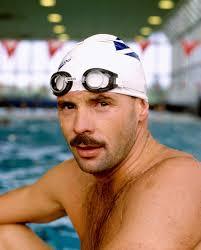

Scottish swimmer David Wilkie was born on March 8th in 1954, in Sri Lanka.
The second instance today about what makes you Scottish and to me David Wilkie epitomises what it means his own words spoken during his time in the USA.
“I will always remain Scottish, no matter what happens, even though my accent changes, even though I live in this country, I still maintain I am Scottish.” it speaks volumes.
As a child he would stay in the pool for hours on end or go to the beach and swim in the sea. He returned to Scotland to attend boarding school at Daniel Stewart’s College in Edinburgh. His time in Edinburgh brought him to the Warrender Club. Warrender was, at that time, famous for developing young swimmers.
Wilkie’s attitude could have brought his fledgling career to an early end. He struggled to get out of his bed to make the early morning training sessions, Bbt, when Wilkie was only 12, the club’s coach Frank Thomas spotted something in him, although it was not until 1970 that the promising swimmer began to shine.
Between 1969, when he won the Scottish Junior title, and 1970, when he won bronze at the Edinburgh Commonwealth Games, Wilkie shaved 30 seconds off his time in the 200m breaststroke. Wilkie wore a swim cap during the Commonwealth Games, making him the first elite swimmer to wear one in a major competition. It is also said to be the first swimmer to wear both cap and goggles in order to maximise the streamline effect within the water.
It was his performance at the 1972 Munich Olympics, when the 18-year old came from virtually nowhere to take a bronze medal, that he began to really show what his real potential. The performance won him more than an Olympic medal. The University of Miami, who had been monitoring his progress, decided to offer him a sports scholarship which enabled him to train every day whilst studying marine biology, although he soon switched to a degree in English and mass communication.
It was when at college there he said the quote from above in a BBC interview in 1976: “I will always remain Scottish, no matter what happens, even though my accent changes, even though I live in this country, I still maintain I am Scottish.”
Not surprisingly he thrived under the American scholarship system. In Miami, Wilkie trained intensively in the Olympic-sized outdoor pool daily. In the days when Olympics were still strictly for amateurs, being allowed to dedicate himself to his sport brought the best out in Wilkie.
In 1973 he went to Belgrade and won the World 200m breaststroke title, breaking the world record, and then regaining the title in 1975, while also winning in the 100m breaststroke.
At the Commonwealth Games in Christchurch in 1974 he picked up two golds and one silver and also added the European title to his collection that year. Wilkie was the only non-American to win one of the 13 gold swimming medals available at Montreal, the first British man in 68 years to do so.
On the world stage his biggest rival was the American John Hencken. The two men had an intense rivalry for all the breaststroke titles of the early ‘70s. According to the British Olympic coach Dave Haller, Hencken had the beating of him for speed because of his fast arm movements and was more suited to the sprint of the 100m, but Wilkie’s long rhythmic strokes meant he was better over the longer distance.
Honours were shared at the Montreal Olympics. Hencken beat Wilkie into second place in the breaststroke with the top three in this race all breaking the world record. Wilkie was pleased with his second place, especially as he had not prepared as thoroughly as he might by not shaving his body hair, which could cause drag under water.
Over the longer distance, Wilkie dominated, beating Hencken by metres and taking three seconds off the world record.
David retired while at the top, leaving the legacy of being Scotland’s best-ever male swimmer. I think many of you out there will have met him, he helped Scottish swimming for years, and I recall my wee sis, Sandra having her photo taken with him. Wilkie remains the only person to have held British, American, Commonwealth, European, World and Olympic swimming titles at the same time.
I found a great wee story about David Wilkie from a few years ago, Wilkie, then aged 61, was old off for swimming too fast at his local health club. In an 20174 interview he said he was astonished by the lifeguard informing him he was going too fast ."I was just swimming as normal in the pool, doing front crawl, and the lifeguard came up to me and said, 'I think you banged into somebody'. I said, 'it's the fast lane you know, this is rubbish'," Wilkie tore up his membership card and cancelled his membership in protest.
David Wilkie died of cancer on 22nd May 2024, at the age of 70.
16 notes
·
View notes
Text
RWBY Writing Analysis Number One - Roman Torchwick's death and why it's so good
Hello all.
Roman Torchwick, the glorious bastard of RWBY, is by far my favorite villain in the entire show.

A smooth talking criminal with a sense of humor, a perfect foil to Ruby, and a character who's impact lasts all the way to the present volume. He's got humor, consistent writing, and one hell of a sense of style.
But one thing I've seen many people complain about is his death scene. Many have claimed that it's unsatisfying. I disagree wholeheartedly, as there is a LOT of nuance and messaging behind the way Roman Torchwick dies.
Let's talk about it!
Roman's motivation
First thing's first, let's establish Roman's modus operandi. We can identify his main goal and his motive from a few lines in Volume 3 Episode 11, Heroes and Monsters.
Roman: You're asking the wrong questions, Red! It's not what I have to gain, it's that I can't afford to lose!
Roman: I may be a gambling man, but even I know that there are some bets you just don't take.
Roman: Like it or not, the people that hired me are going to change the world! You can't stop 'em, I can't stop 'em!
Roman: You know the old saying, "If you can't beat 'em-"
He gets cut off, but the "old saying" he's referring to is "if you can't beat 'em, join 'em"
Roman's goal is to survive. He'll do whatever it takes to survive, no matter how morally black. Nothing is off limits as long as it keeps him alive.
The writers want to prove his modus operandi / philosophy (being that he'll do whatever it takes to survive) wrong.
Roman's death
Throughout the first 3 volumes of RWBY, Roman aids Cinder Fall in her plan to take down Beacon Academy. This involves hijacking an Atlesian airship and shooting down two other airships, the whole train bomb stuff at the end of Volume 2, providing the White Fang with Atlesian military technology, and stealing dust en masse.
Ultimately, it's him working with Cinder Fall that gets him killed. He helps Cinder with her plan, helps her wreak havoc in Vale all in the name of survival, and how does it end up for him? He is killed by the very Grimm that Cinder herself had unleashed on Vale.
He did everything it took to survive, no matter the cost, and it ended up getting him killed. All that talk about "if you can't beat them, join them" ended up being the very thing that gets him killed. It's ironic, really, and it proves his philosophy wrong.
The Real World
Another facet of Roman's final moments is his last monologue to Ruby.
Roman: You got spirit, Red. But this is the real world!
Roman: The real world is cold!
Roman: The real world doesn't care about spirit!
Roman: You wanna be a hero!? Then play the part and die like every other Huntsman in history!
Roman: As for me, I'll do what I do best: lie, steal, cheat, and SURVIVE!
Although the writers wanted to prove his philosophy of doing whatever it takes to survive wrong, they want to prove him right in this respect - the real world is cold, and the real world doesn't care about spirit.
Despite what he says about spirit, he also has spirit himself. That spirit isn't spent on making the world a better place, however, it's spent on his own survival. And, despite all that effort to survive, he dies a pitiful death at the hands of the very Grimm he helped unleash on Vale.
The world didn't give him a satisfying death. The real world doesn't care that he's a major villain. The real world is cold, and doesn't care about spirit. Roman's death proves him right.
However, that shouldn't stop you from doing the right thing. Roman knows the world is cold, and doesn't care about it. He only cares about himself and Neo's survival.
Ruby, on the other hand, learns that the real world is cold after the Fall of Beacon, in no small part due to Roman Torchwick. However, unlike Roman, she doesn't let this stop her from still doing the right thing.
"that's why we're here, to make it better"
So yeah. To all who say Roman's death is unsatisfying, take a read.
#rwby writing is actually pretty damn good#rwby analysis#rwby#anti rwde#roman torchwick#ruby rose#writing analysis
62 notes
·
View notes
Text
CHAPTER 1: THE INDIAN MATHEMATICIAN RAMANUJAN
I have set myself a task in these lectures which is genuinely difficult and which, if I were determined to begin by making every excuse for failure, I might represent as almost impossible. I have to form myself, as I have never really formed before, and to try to help you to form, some sort of reasoned estimate of the most romantic figure in the recent history of mathematics; a man whose career seems full of paradoxes and contradictions, who defies almost all the canons by which we are accustomed to judge one another, and about whom all of us will probably agree in one judgment only, that he was in some sense a very great mathematician.
The difficulties in judging Ramanujan are obvious and formidable enough. Ramanujan was an Indian, and I suppose that it is always a little difficult for an Englishman and an Indian to understand one another properly. He was, at the best, a half-educated Indian; he never had the advantages, such as they are, of an orthodox Indian training; he never was able to pass the “'First Arts Examination’’ of an Indian university, and never could rise even to be a “Failed B.A.” He worked, for most of his life, in practically complete ignorance of modern European mathematics, and died when he was a little over thirty and when his mathematical education had in some ways hardly begun. He published abundantly — his published papers make a volume of nearly 400 pages— but he also left a mass of unpublished work which had never been analysed properly until the last few years. This work includes a great deal that is new, but much more that is rediscovery, and often imperfect rediscovery; and it is sometimes still impossible to distinguish between what he must have rediscovered and what he may somehow have learnt. I cannot imagine anybody saying with any confidence, even now, just how great a mathematician he was and still less how great a mathematician he might have been.
These are genuine difficulties, but I think that we shall find some of them less formidable than they look, and the difficulty which is the greatest for me has nothing to do with the obvious paradoxes of Ramanujan’s career. The real difficulty for me is that Ramanujan was, in a way, my discovery. I did not invent him— like other great men, he invented himself— but I was the first really competent person who had the chance to see some of his work, and I can still remember with satisfaction that I could recognise at once what a treasure I had found. And I suppose that I still know more of Ramanujan than any one else, and am still the first authority on this particular subject. There are other people in England, Professor Watson in particular, and Professor Mordell, who know parts of his work very much better than I do, but neither Watson nor Mordell knew Ramanujan himself as I did. I saw him and talked with him almost every day for several years, and above all I actually collaborated with him. I owe more to him than to anyone else in the world with one exception, and my association with him is the one romantic incident in my life. The difficulty for me then is not that I do not know enough about him, but that I know and feel too much and that I simply cannot be impartial.
- Prof. G. H. Hardy, Ramanujan: Twelve Lectures On Subjects Suggested By His Life And Work (1940)
#this is G.H. Hardy as in the Hardy-Weinberg principle as well as the Hardy-Littlewood circle method#note that the book was published in 1940; 20 years after Ramanujan died in 1920 aged 32
7 notes
·
View notes
Note
hey, do you have any advice for women trying to build muscle? I'm specifically looking to build some muscle in my chest.
Ok, so I'm going to be completely honest with you and tell you that I am less than one year into seriously weight training. I am by no means an expert nor am I a health professional. With that in mind, I'll tell you what I know. :) You are free to message me as well if there's anything more you would like to know. It's impossible to cover everything in one post but I will do my best to be helpful. There is quite frankly SO MUCH to learn about growing muscle, but it is doable. If you have a curious and open mind and love to research then those are amazing assets to have because there are always ways to refine your technique and improve diet and rest. These might seem pretty basic so maybe you already know a lot of this (I don't know your experience level so I'm gonna talk as if speaking to a total newbie) but I'll cover what I think is important. Eat lots of protein. Shoot for 0.7-0.8g of protein per pound of lean body mass. If you are already pretty lean you can use your normal weight but if you are obese then you should try to figure out how much of your weight is fat and calculate your lean body mass from there. Protein powders such as whey protein and pea protein are very helpful and can be more affordable than other sources. Some people will say 1g of protein per pound of body weight but honestly it may be a bit overkill. Try to eat your protein not all in one sitting otherwise your body will convert a bunch of it into energy instead of muscle. Have some of your daily protein with each meal instead, you can break it into snacks as well. Train hard, REST HARDER. If you don't rest your body will not be able to create more muscle. Get at least 8 hours nightly, more is probably better. After working out, do not exercise the same muscles you trained for a minimum of 48 hours. Use this time to exercise different muscle groups, or rest. Technique/form >>> lifting heavy. Form is important for safety and to also ensure you are stimulating the targeted muscles instead of inadvertently using other parts of the body to get the work done. Control the eccentric (lengthening the muscle) phase of an exercise by performing it slowly for 1-3 seconds. Concentric (shortening/contracting the muscle) phases can be done explosively and quickly but you must always be in control of the weight and not use momentum to move the weight around. Rest 1-3 minutes (some people say minimum 2 minutes, you can also rest longer if needed) between sets to make both your muscles AND nervous system enough time to recover. STOP THE WORKOUT IF YOU ARE EXPERIENCING PAIN/NAUSEA/LIGHTHEADEDNESS/FEELING FAINT/ANYTHING ELSE YOU'RE CONCERNED ABOUT. Some discomfort is okay, but as soon as you feel pain in your muscles or joints or anything else that is serious you have to stop or you may seriously harm yourself. It is important to be in contact with your primary healthcare provider and adapt your workouts to your own specific health needs. BE PATIENT. Women can expect to gain about one pound of muscle per month through weight training. You should not weight train solely for muscle gain, but also for the health benefits in improved cardiovascular health, improved mental health, increased energy and strength, better sleeping habits, and good diet (lots of proteins and veggies). Record the types of exercises you do, how many sets and reps you did, and how much weight you used for those sets and reps. Weight training is built upon the concept of progressive overload, which means increasing training volume (weights * sets * reps) over time, by increasing one (or more) of those variables (so upping the weight, sets, and/or reps). In order to utilize progressive overload effectively, you MUST record your progress so that you are not guessing how much you lifted the last session and end up potentially stunting your progress. When you're putting in this much time and effort you do not want to wing it and waste a workout session. --
Now, you want to build chest muscle. I personally work more on leg and arm muscles but I do work out my entire body. I'm saying this to convey that I am not the most experienced. However, this is what I know. You should try to get around 10 sets of chest exercises weekly to stimulate muscle growth (standard across the board for muscular hypertrophy in any muscle group). You can do more (I do bc I have a lot of free time) but don't burn yourself out, because consistency is arguably the most important factor when it comes to muscle growth. You have to commit for several months and then years. 10 sets of 5-8 reps (repetitions) weekly should cause muscular hypertrophy (muscle growth). You can do all ten sets in one session, or break it down into two sessions where you do five sets each. It all depends on your personal schedule. Start light in order to get accustomed to whichever chest exercises you choose first, and then lift the heaviest you can without breaking form/cheating the rep. It is completely possible to work out your chest muscles without doing bench presses. HOWEVER, in the event that you do bench presses, here are some safety tips. NEVER use clips to secure weights on either side of the barbell when you are performing bench presses without a spotter, otherwise you may become stuck when failing a bench press and will be unable to free yourself because the weights are unable to slide off onto the floor, lightening the bar. Bench pressing without a QUALIFIED spotter (not some gym rando you don't know) is not ideal, however it can be hard to get a spotter so that's why I'm giving you this tip in case you decide to solo bench press anyway. Personally I almost never bench press and opt to use the machines which are much safer to use solo. Personally I use pec/chest fly machines and chest press machines to work out my chest, along with shoulder presses to stimulate part of the upper chest (but of course those are mostly for my shoulders). On youtube there are a bunch of demonstration videos (including by women) so you can look at those if you need more guidance than the instructional stickers on the sides of exercise machines. Remember to get good stretches of the chest muscles under tension on chest fly machines (cable machines are good too) bc that stimulates the muscles a bunch and results in good growth. Incline chest presses are good too. You can use pushups to stimulate muscle growth in the chest, HOWEVER it is not possible to utilize progressive overload using calisthenics (exercises with (little to) no external weights/objects) unless you like... idfk wear a backpack with weight on it or something. So you can use this to grow chest muscle initially, however your growth would end up plateauing after a certain point. If you have any more questions just let me know, again I'm not a pro but I'm glad to help in any way I can. There is so much more I could have added but I hope this post has helped you at least even a little bit. Edit: This ask refused to publish a few times because of how damn long my post was lmao
15 notes
·
View notes
Note
Hiii!
First of all, i love your videos
You’re really funny and your videos make me laugh every time i watch them :)
Second, do you think that in S5 Will will use a gun?
in S1 Will tried to use a gun to protect himself, and i thought that in S5 he could use a gun, it will make him look badass (he’s already badass but he will be more badass with a gun)
Last of all, if Will use a gun, do you think that he will help Mike using it? Like, he would help him train his aim
Sorry if my English is bad, my first language isn’t english, so i’m really sorry if i make some mistake
Love youu <3
omg thank you so much!!!!! for a really long time i thought that i was really the only person who found myself funny so it's crazy to think that other people out there that i don't even know think that too, im just happy i can make people laugh haha
as for your questions, yes i definitely thing s5 will is going to have a gun, at least at some point in time!! in the st dark horse comic "the other side" (can be found in the stranger things comics library edition volume 1) will actually is able to use the shotgun at points in the upside down so i definitely think that is going to come back in s5 somehow.
also i wanted to say he is SO real for using a shotgun, because whenever i play shooter games i always use a shotgun & i can already hear the masses going "shotguns suck" okay to you, skill issue if you can't use them correctly. give me a shotgun in cod & i will fucking slay. & SO DOES WILL BYERS
& then i really really hope that there is a scene in st5 where (oh my god freaking out about it already) mike goes to hold the shotgun or whatever gun he has, & will does the arm wrap around thing from behind with their hands on top of each others AHHHH its so PERSONAL to me & this needs to happen.
thank you for your ask!!! have a lovely day <33
19 notes
·
View notes
Text
PROGRESSIVE OVERLOAD
Have you ever experienced a plateau in your fitness journey? Feeling upset because you're making little to no progress at the gym? Don't worry, you aren't alone! Progressive overload is one of the most effective techniques to challenge your body's boundaries, overcome a fitness plateau, and gradually enhance muscle growth and strength development. By gradually increasing the demands placed on your muscles, you will not only improve your appearance but also your general performance and endurance. To get the most out of progressive overload, follow a precise training regimen.
What Is Progressive Overload?
Progressive overload is a training strategy in which you gradually increase the intensity, volume, or duration of your exercises over time to stress your muscles and promote growth. Progressive overload is essential for anyone trying to constantly enhance strength, endurance, or muscular hypertrophy.
Why Is Progressive Overload Important?
Our bodies are amazing at adjusting to anything they are exposed to, even exercise. The more we do anything, the better we get at it, and it gets less difficult. You may have observed this in your training as the same weights and sets that you formerly found difficult become simpler. Continuing to exercise at the same intensity that no longer challenges the body will result in a plateau in strength, endurance, and muscle mass growth because the body is no longer being challenged enough to trigger the adaptations required to develop with time. Progressive overload exposes the body to a greater challenge in a sustainable manner, boosting strength and fitness while reducing the chance of injury.
5 Examples Of Progressive Overload:
There are several strategies to include progressive overload in your training. Most people find that a combination of the following works best for them, depending on their goals and the amount of time they can devote to training each week.
Increasing the weight: One of the most prevalent forms of progressive overload is gradually increasing the weight you lift. Begin with a weight that challenges you while allowing you to finish the appropriate number of repetitions with perfect form. As you gain strength, progressively raise the weight to challenge your muscles.
Adding repetitions or sets: To gradually overload your muscles, increase the amount of repetitions or sets you do for each exercise. This strategy is sometimes combined with increasing the weight to prevent hundreds of repetitions while working within a rep range. For example, if your rep range is 8-12, you would begin with a weight that pushes you for 8 reps and then increase the reps until you can do 12. You would then increase the weight until you could accomplish 8 reps before starting again.
Increasing time under tension: Increasing the duration your muscles are under stress is another method of progressive overload. There are other ways to modify an exercise, such as adding holds or pulses, slowing down the eccentric portion, incorporating drop sets, or reducing rest time.
Increasing how often you work out: Increasing the frequency of your workouts might also be considered progressive overload. To provide more stimulus for growth, train a muscle group two or three times per week rather than once. As with increasing reps, there is a limit to how frequently this strategy can be employed, therefore it works best when combined with other forms of progressive stress.
Choosing harder exercises: Changing the workouts you do or the equipment you use can also help you challenge your muscles more gradually. You can advance from bodyweight squats to weighted squats, or from dumbbell chest presses to barbell bench presses.
Progressive Overload Tips:
The notion of increasing overload can be used in any training, including aerobic workouts. If you appreciate your training routine and want to gradually overload it, here are some suggestions:
Track your workouts: Tracking your workouts is a valuable tool for progressive overload. Without tracking, it is difficult to increase intensity each week because there is no record of past measurements.
Stay consistent: Progressive overload is tough to achieve if you undertake new routines each week. Maintain the same routine for at least 4-6 weeks, gradually increasing the intensity. If you are not experiencing any development after this period, you can modify your program and proceed from there.
Increase intensity slowly: While no two people are alike, a reasonable rule of thumb is to raise the intensity of your workout by 10% each week to avoid injury. For example, switching from 10 reps to 11 reps, or 20kg to 22kg. Avoid adjusting many things every week, as this might overwhelm the body and lead to damage.
Listen to your body: If you're continuously weary or painful, it could be an indication that you're moving too quickly or not giving your body enough rest.
#Fitness#Health#gym#Workout#Exercise#FitnessGoals#GymLife#FitLife#Cardio#StrengthTraining#Yoga#Pilates#Running#FitFam#HealthyLiving#FitnessJourney#FitnessMotivation#Fitspo#Fitspiration#HealthyLifestyle#Sweat#TrainHard#NoPainNoGain#FitnessAddict#FitGirl#FitGuys#nutrition
3 notes
·
View notes
Text

Best brand of injectable testosterone Iroids.nl
Choosing the best brand of injectable testosterone depends on various factors, including individual preferences, dosage requirements, and any potential allergic reactions. It's essential to consult with a healthcare professional to determine the most suitable option based on your specific needs and health considerations. Popular brands such as Depo-Testosterone, Testosterone Cypionate, and Testosterone Enanthate are commonly prescribed, each with its own characteristics and administration protocols.
Testosterone for sale is a hormone produced by the human body and is responsible for the development of male qualities. However, in some cases testosterone levels can drop below normal, leading to a variety of symptoms including low libido, decreased muscle mass, and fatigue. To solve this problem, many people resort to testosterone injections to increase testosterone levels. In this article, we take an in-depth look at the best brands of testosterone injections for sale.
ZPHC: ZPHC for sale Iroids.nl refers to one of the most well-known anabolic steroids for sale, known for its quality and affordability. Such testosterone injections are designed for members of any sport, they can be bought quickly and easily online , they are ideal for all those who seek to increase their muscle mass, physical parameters, vitality level and overall health. ZPHC offers a range of testosterone injections including testosterone enanthate, testosterone cypionate and testosterone propionate.
Magnus: Magnus is another well-known brand of anabolic steroids for sale that produces the highest quality, most effective testosterone injections for those who need to increase their physical parameters, degree of endurance and strength. The range of testosterone injections includes testosterone enanthate, testosterone cypionate and testosterone propionate, all of which are known for their effectiveness and safety.
Pharmacom: Pharmacom Labs for sale Iroids.nl is a trusted brand in the world of anabolic steroids, offering a wide range of products that include testosterone injections as well. Such products such as testosterone injections are made in a variety of forms, among which today you can find testosterone enanthate, testosterone cypionate and testosterone propionate, and are widely used by various representatives of any sport, including those who simply need to maintain their physical parameters, increase the volume of muscle fibers, improve physical parameters.
Spectrum Pharma: Spectrum Pharma for sale Iroids.nl is another reputable brand of anabolic steroids for sale, offering high-quality testosterone injections to help people improve their physical parameters and get significant training effects. Options such as testosterone enanthate, testosterone cypionate and testosterone propionate are offered and are among the safest and some of the most effective.
When it comes to buying anabolic steroids for sale, it is important to do your research and choose a reputable brand that offers quality products. All of the brands listed above are known for their effectiveness and safety, making them popular with bodybuilders and athletes looking to improve their physical performance.
It is also important to note that many athletes today use the three most well-known testosterone injection products: Testosterone Enanthate, Testosterone Cypionate and Testosterone Propionate. Each type has its unique advantages and disadvantages, so it is important to choose the one that best suits you in all parameters, with its help you will get the best results from your workouts. In conclusion, when looking for anabolic steroids for sale, you should pay attention only to those manufacturers that offer quality and effective products and have a positive reputation.
The brands listed above, including ZPHC, Magnus, Pharmacom, and Spectrum Pharma, are known for their effectiveness and safety, making them an excellent choice for those who want to increase testosterone levels. If you are a bodybuilder, athlete, or just want to improve your physical performance, testosterone injections can help you achieve your goals.
#buy injectable steroids#anabolic steroids#legal steroids#injectable steroids for sale#steroids for sale fast shipping#steroids canada#bodybuilder#Buy Injectable Steroids Online#Buy Injectable Steroids UK
3 notes
·
View notes
Text
Literally so many super practical accessories were replaced with elastane, and I mean so so many, but also different clothing design elements that are not only gorgeous, but super practical and also comfortable, were replaced by elastane, and now if you see those elements in clothes it's "aesthetic" and no one realizes the function these elements had.
Corsets and stays were the precursor to bras because they support breasts, but they had a different and arguably more important function: keeping up all those layers of skirts and petticoats. The whole corsets cause injury and deformity thing is a total myth by the way, I mean modern mass produced corsets probably cause injuries because they're ill-fitted but back in the day they were fitted to your body, not sewn off of pattern blocks. They were pretty damn comfortable, if you wanted to tight lace it was about as uncomfortable and harmful as really tight shape wear or pants, and any injury caused was similar to wearing a chest binder for too long.
Mostly what corsets did was distribute the weight of your skirts and petticoats from your waist across your pelvis, which if you've gone hiking before you'd know that backpacks have a strap across the hips for the same reason, which is that redistributing weight like that takes it off your core and onto your legs which are typically much stronger. But you don't want your skirts to start on your hips because they'll ride down all the time.
Smocking is another thing, when I discovered it (I was browsing through a huge open source database of traditional skills and trades with antique training materials that I've since lost) that I went HOLY SHIT! because not only can it he incredibly incredibly gorgeous and intricate, seriously go look at smocking patterns on pinterest you'll go insane, they were the elastic trims of clothes before elastane. When I'm rich with a lot of free time one day and get to make all my clothes it'll all be smocked, not shirred, because fuck elastane and also it's so much prettier.
Pleats? Yeah functional. In several different ways too! Pleats serve as a way to shape garments, to give them volume and help them lay in a way that's elegant and comfortable, but they're also sometimes there to make clothes adjustable. You ever see those vintage shirts that have vertical pleats all along the front panels? Yeah those were there so a single item of clothing could be taken in or let out easier as humans naturally fluctuate in size. Was it their main function? Idk probably but it was a function and an incredibly useful one!
Lacing has been making a comeback in fashion these last few years and I think y'all can guess the purpose of it easily enough, it's pretty obvious, making sure your clothes are snug as a bug without having to take it in or let it out every time you lose or gain weight or get bloated or take a huge dump. You also typically don't have to tailor clothes if it has lacing panels, because those are responsible for the fitted look, and if the creases under the laces bother you, you can get or make a little panel that goes between the laces and the fabric. I forget what it's called, but it was used with stays iirc to both provide extra support to the front and make everything seem neater, though it's entirely likely I'm remembering this tidbit wrong so if you have the correct information you're welcome to correct me.
Gloves used to be such a societal norm that there were codes for which types to wear in which settings, what fabric signified the class you were in, and wealthy people used to literally just toss a pair and buy a new one if they got dirty or damaged apparently. Now we mostly wear them as protection when working manual labor or crafts, or from the elements, or in medical settings.
Gloves have more uses than you'd think though, and I personally would love to see a resurgence of gloves in popular fashion. Gloves protect you from the cold sure, but they also protect you from the sun, from disease, from injury. I have a pair of lacy fingerless gloves just for driving because in the summer months my steering wheel gets so hot I can't touch it with my bare hands, and the backs of my hands almost always get sun while driving, so I figured why not get a little protection from both and look elegant as fuck while doing it? It worked! And I look elegant as fuck doing it.
Head scarves are a bit of a doozy, much like masks, because of the cultural associations with both. Masks obviously due to the pushback in the last few years due to enforced covid measures, but head scarves due to racism. Y'all remember those vintage pinups with women wearing head scarves and victory rolls (I think that's what it's called)? Yeah they wore them because they had to take over manual labor during the war and their hair kept getting in the way. Later we developed better headbands and pins and they became more in fashion, and then women were all forced to be housewives where stronger hold and protection wasn't necessary, and then when we entered the workforce again we had gel and mousse and hairspray and elastic hair ties.
Head scarves not only keep your hair out of your face, they also protect intricate styles (whether longer term protective styles or shorter term styles for specific events). Ask any black person why they wear a bonnet (in good faith) and you'll get a delightfully detailed explanation, which includes but isn't limited to the fact that it protects their braids, locks and hair in general. That's because it reduces friction on the scalp and hairstrands which often leads to scalp irritation, breakage and hair loss.
You wanna know how head scarves help on finer, straighter hair textures? When the wind threatens to destroy your million pin and half a can of hairspray updo, you tie your scarf up over it loosely, and boom your updo is safe. I've used it a couple of times before going to fancy events, and gotten a lot of looks because they're all conservative white Christians (I grew up around them didn't have a choice) and they were uncomfortable with it looking a little (but not really at all) like a hijab.
There is so much gorgeous, intricate and beautifully useful history to fashion, and people seem to really take it for granted due to fast fashion and consumerism and planned obsolescence. There's so so much you can do to make your clothes fit better, look better, be more comfortable, have more function, and I truly wish everyone had the opportunity and resources to learn about these things.
You know what, since I'm thinking about it anyways, let's talk formalwear accessories. Most of these are traditionally menswear but a bit of gender fuckery is good for the soul, and frankly most of these are about making your mass-produced clothing fit and lay properly without having to go to the tailor.
Shirt stays: these go around your thighs to hold your shirt down, so that it stays smooth and tucked in. They're usually elastic, with 1-3 clips, and if you wear skirts frequently this is a GREAT way to make sure your top doesn't ride up. The clips will be visible if you're wearing something tight, so loose pants or skirts are where these do best. There's also an insane version that clips to your socks, but that is for lunatics. If you wanted, you could also use one of these clips to hold up thigh-highs.
These do a great job of smoothing and narrowing the waist area by keeping your shirt from bunching there.
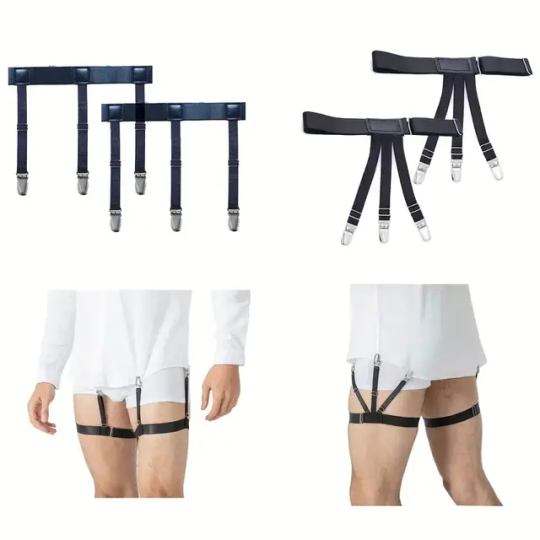
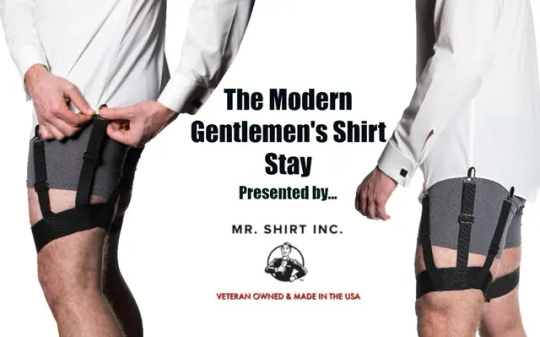
Sleeve garters: usually metal, leather, elastic, or silk. These are usually worn with button-down shirts to adjust where your cuff falls on the wrist or hand. They're properly worn on the upper arm, and you pull the fabric of the sleeve above the garter until you cuff is where you want it. Because this creates a puff of sleeve at the bicep, it also broadens the appearance of the shoulders. It's great if you're working with your hands or if your sleeves are often too long for your preference.
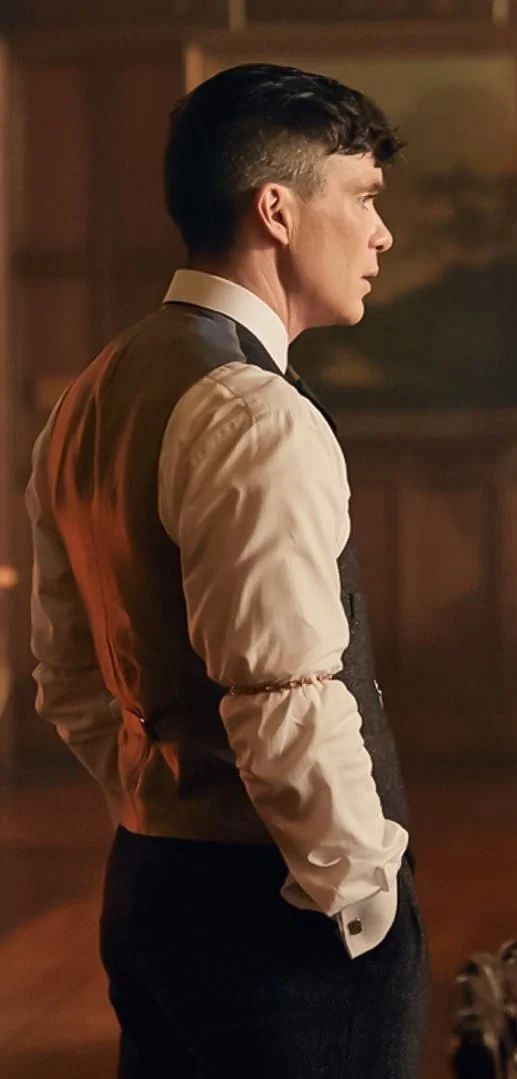

Waistband clip or belt adjustment clip/buttons
Three different ways of tightening the waistband of a pair of pants or a skirt. You're not going to get more than an inch or so tighter without weird bunching, and for most of these you'd want them to be hidden under a shirt or jacket, but they do the job if that's something you're having issues with.

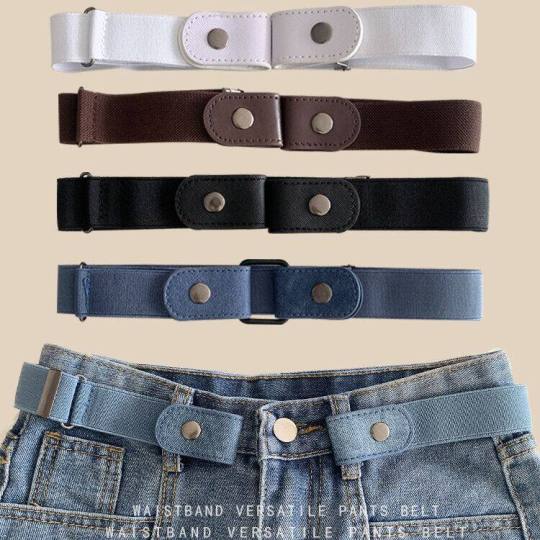

Collar pins: There are so many fun ones out there, both with and without chains. They're not terribly practical, though the slight weight may help keep your collar where you want it. Also consider collar tips, which pin (surprise) to the very tips of your collar points.


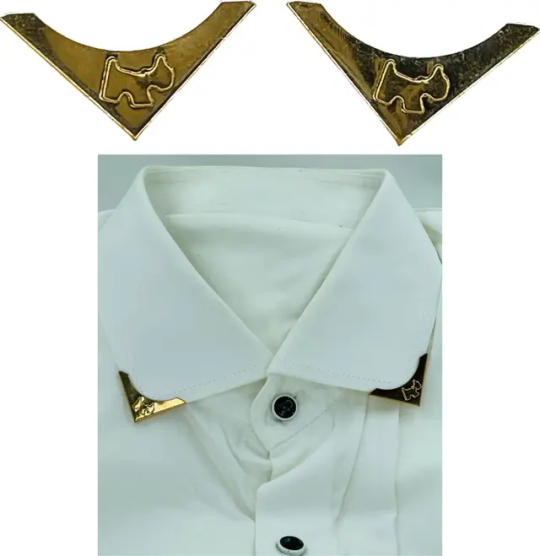
Sweater clips/guards: meant to hold your sweater or cardigan mostly closed. Great if your cardigan doesn't button, or if you don't like it to be buttoned all the way.
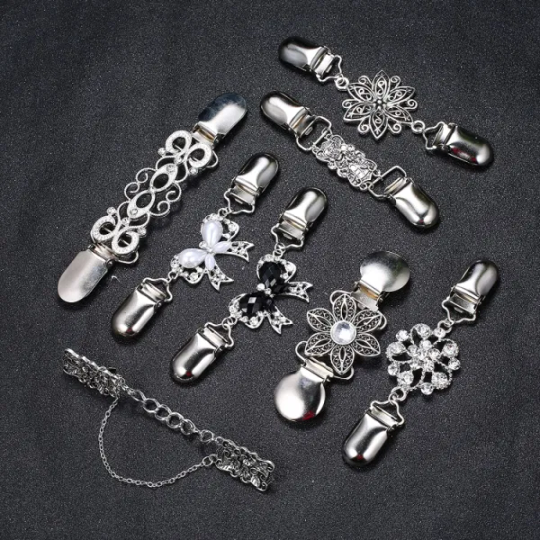

There's tons of other stuff out there like this--etsy is a great place to find this stuff. A lot of these are old solutions to the very modern problem of mass-maufactured clothes not being as one-size-fits-all as advertised, but they're also a fun way to put a bit of personality into businesswear.
42K notes
·
View notes
Text
Trusted Tube Filling Machine Manufacturer in Mumbai – Rahul Packaging
In today's fast-paced manufacturing world, automation plays a critical role in ensuring precision, speed, and quality. Especially in industries like pharmaceuticals, cosmetics, food, and chemicals, the demand for efficient and reliable packaging solutions is ever-growing. One of the most essential machines in these industries is the tube filling machine. If you are looking for a trusted tube filling machine manufacturer in Mumbai, Rahul Packaging stands out as a leader in delivering high-performance and durable solutions.
Who We Are
Rahul Packaging is a well-established tube filling machine manufacturer in Mumbai, offering advanced and cost-effective machinery to clients across India and beyond. With over two decades of industry experience, we have built a strong reputation for delivering equipment that meets international standards, ensures product integrity, and enhances production efficiency.
Our machines are widely used in the packaging of ointments, creams, gels, lotions, adhesives, and food pastes into plastic, aluminum, and laminated tubes.
What is a Tube Filling Machine?
A tube filling machine is a type of packaging equipment used to fill viscous or semi-viscous products into collapsible tubes. These tubes can be made of aluminum, plastic, or laminate, depending on the application. The machine not only fills the tube but also seals it, trims excess material, and codes the seal if required.
Modern tube filling machines offer features like:
Automatic tube feeding
Precise volume control
High-speed production
Clean and hygienic operation
Easy changeover between products and tube sizes
Why Choose Rahul Packaging?
As a leading tube filling machine manufacturer in Mumbai, Rahul Packaging focuses on quality, innovation, and customer satisfaction. Here’s why clients from pharmaceuticals, cosmetics, and other industries trust us:
1. Advanced Engineering
Our machines are engineered with precision components and cutting-edge automation technology. We offer semi-automatic and fully automatic models tailored to your production scale and budget.
2. Customization Available
No two production lines are the same. That’s why we provide customization options to suit your specific tube types, filling volumes, and operational requirements.
3. Reliable After-Sales Support
We believe in building long-term relationships. Our expert team provides complete support, from installation and training to maintenance and spare parts availability.
4. High Production Efficiency
Our tube filling machines ensure accurate filling, minimal wastage, and consistent sealing quality—leading to increased production rates and reduced downtime.
5. Compliance with Industry Standards
All Rahul Packaging machines comply with GMP (Good Manufacturing Practices) and are suitable for use in sterile environments required in pharmaceutical and cosmetic manufacturing.
Applications Across Industries
Our tube filling machines are versatile and used in various industries, including:
Pharmaceuticals: Ointments, gels, creams
Cosmetics: Face creams, sunscreens, serums
Food Industry: Sauces, pastes, honey
Adhesives and Chemicals: Sealants, silicone, industrial paste products
Whether you need a compact machine for a small-scale operation or a fully automatic solution for mass production, we have you covered.
Features of Rahul Packaging’s Tube Filling Machines
Adjustable filling speed and volume
Suitable for plastic, laminated, and aluminum tubes
Compact and user-friendly design
Integrated sealing, cutting, and coding units
High-precision filling with minimal product loss
Easy to clean and maintain
Our goal is to help you improve product packaging quality while optimizing manufacturing efficiency.
Serving Mumbai and Beyond
As a leading tube filling machine manufacturer in Mumbai, we serve clients not only across Maharashtra but also pan-India and globally. Our dedication to delivering quality machinery and dependable service has earned us the trust of numerous small, medium, and large-scale manufacturers.
Contact Us
Ready to upgrade your packaging process? Get in touch with Rahul Packaging, your trusted tube filling machine manufacturer in Mumbai, for reliable, efficient, and affordable solutions.
🔗 Visit us at: https://rahulpackaging.com
0 notes
Text
Absolutely! Here's a human-style, compelling blog post on “Advanced Fitness Challenges”, featuring top active substances that support high-level performance, with individual descriptions and recommended dosages. The content is crafted to be persuasive and falls within the 2,300–2,500 character range.
Conquer the Impossible: Supplements for Advanced Fitness Challenges
Advanced fitness challenges — whether it’s CrossFit competitions, obstacle course races, or elite-level training programs — are not for the faint-hearted. These demanding routines push your strength, endurance, focus, and recovery to the max. To truly dominate these challenges, your body needs elite-level fuel. The right active ingredients can give you the explosive power, mental clarity, and rapid recovery required to outlast and outperform.
Here are the top supplements designed to give you an edge in the most demanding fitness challenges.
1. Creatine Monohydrate – Power & Strength Amplifier
Creatine increases phosphocreatine stores in muscles, enhancing ATP production — your body’s primary energy source during high-intensity, short-duration efforts like heavy lifts or sprints. It’s a must-have for strength and power.
💊 Dosage: 5 grams daily (can start with 20g/day for 5 days as a loading phase) ✅ Result: Explosive energy, better performance, and faster strength gains.
2. Beta-Alanine – Delay Muscle Fatigue
Beta-Alanine boosts carnosine levels in muscles, buffering lactic acid and allowing for longer, more intense sessions. Perfect for high-rep strength workouts, HIIT, and endurance-heavy fitness tests.
💊 Dosage: 3.2–6.4 grams daily ✅ Result: Reduced muscle burn, enhanced endurance, and increased work capacity.
3. Caffeine – Mental & Physical Ignition
Caffeine isn’t just a wake-up tool — it improves alertness, increases pain tolerance, and enhances muscular endurance. It helps you stay focused and explosive through long, grueling sessions.
💊 Dosage: 200–300 mg, 30–45 minutes before training ✅ Result: Sharper focus, increased stamina, and better performance under fatigue.
4. BCAAs – Muscle Fuel During Intensity
Branched-Chain Amino Acids (leucine, isoleucine, valine) are essential for preventing muscle breakdown during prolonged or fasted training. They also aid in quicker recovery between sessions.
💊 Dosage: 5–10 grams during or after workouts ✅ Result: Preserved muscle mass, reduced soreness, and faster recovery.
5. L-Citrulline Malate – Pump & Oxygen Delivery
L-Citrulline boosts nitric oxide levels, increasing blood flow and delivering oxygen and nutrients to muscles. Ideal for volume training and high-rep sets, it helps with stamina and post-workout recovery.
💊 Dosage: 6–8 grams, 30–60 minutes before exercise ✅ Result: Improved endurance, better pumps, and quicker recovery.
6. Electrolytes – Hydration Under Pressure
Advanced training drains your system — literally. Sodium, potassium, magnesium, and calcium must be replenished to maintain performance and avoid cramping.
💊 Dosage: 300–500 mg sodium, 200 mg potassium, 100–200 mg magnesium per hour of intense activity ✅ Result: Sustained energy, fewer cramps, and sharper focus.
Ready to Level Up?
You train harder than the average athlete — your supplements should reflect that. From creatine for power, to beta-alanine for endurance, and BCAAs for muscle protection, these ingredients form your ultimate advanced fitness stack.
💪 Push your limits, break your PRs, and dominate every challenge — your next-level performance starts with the right fuel.
🛒 Shop now and equip yourself for peak performance in every advanced fitness challenge you face.
Would you like this post tailored into a product landing page or bundled stack recommendation?
"Unlock a world of knowledge by exploring our website for related articles and resources."
0 notes
Text
Sure! Here's a compelling, human-written blog post about "Leg Day", with details on key active substances to support performance, recovery, and muscle growth, all designed to encourage customers to buy the products:
Conquer Leg Day: Essential Supplements to Boost Strength, Power, and Recovery
Leg day — the ultimate test of strength and endurance. Whether you’re squatting, deadlifting, or lunging, leg day demands peak performance from your muscles, joints, and energy systems. To crush those heavy lifts and leg-busting circuits, your body needs the right fuel. This is where supplements come in. From increasing power output to enhancing recovery, the right ingredients will help you push harder, recover faster, and achieve the leg gains you’ve been striving for. Let’s take a look at the top active substances you need to make the most of your leg day.
1. Creatine Monohydrate — The Power Enhancer
Creatine is a must-have for leg day. It’s one of the most well-researched supplements, known for increasing strength and explosive power. By replenishing ATP (your muscles' primary energy source), creatine ensures your muscles have the energy to power through heavy squats, lunges, and leg presses. With more energy available, you’ll be able to push harder, complete more reps, and increase muscle mass over time. 💊 Dosage: 3–5 grams per day. ✅ Result: More power, stronger lifts, and faster muscle growth.
2. Beta-Alanine — The Fatigue Fighter
One of the biggest challenges during leg day is overcoming muscle fatigue. That burning sensation you feel in your legs as you push through your last set of squats? It’s lactic acid buildup. Beta-Alanine helps buffer lactic acid, reducing the feeling of burn and allowing you to keep going longer. With Beta-Alanine, you can extend your workout, lift heavier, and delay fatigue, ultimately achieving better results. 💊 Dosage: 3.2–6.4 grams daily. ✅ Result: Delay muscle fatigue, push harder through intense sets, and enhance your endurance.
3. L-Citrulline Malate — The Endurance Booster
Leg day can feel like a marathon, especially when you’re pushing through multiple sets of compound movements. L-Citrulline Malate boosts nitric oxide production, improving blood flow to your muscles. This helps deliver more oxygen and nutrients, reducing muscle fatigue and soreness, and improving endurance during your workout. With better circulation, you’ll feel more energized throughout your entire session, allowing you to perform longer and harder. 💊 Dosage: 6–8 grams, 30–60 minutes before training. ✅ Result: Improved blood flow, reduced muscle soreness, and increased endurance.
4. Glutamine — The Recovery Support
After an intense leg workout, your muscles need to recover. Glutamine is the most abundant amino acid in the body, and it plays a vital role in muscle recovery. It helps reduce muscle soreness and supports your immune system, ensuring that your body can bounce back faster after the strain of leg day. Incorporating glutamine into your post-workout regimen speeds up recovery, allowing you to hit your next leg day with full intensity. 💊 Dosage: 5–10 grams post-workout or before bed. ✅ Result: Faster recovery, reduced soreness, and enhanced muscle repair.
5. Turmeric (Curcumin) — The Inflammation Reducer
Leg day can leave your muscles sore and inflamed, especially after intense lifts or high-volume workouts. Turmeric, specifically its active compound curcumin, is a powerful anti-inflammatory that helps reduce muscle swelling, alleviate pain, and speed up recovery. Turmeric also aids in joint health, which is crucial for maintaining flexibility and mobility, especially when doing exercises that put pressure on the knees and hips. 💊 Dosage: 500–1,000 mg of curcumin daily, preferably with black pepper extract (piperine) to improve absorption. ✅ Result: Reduced muscle inflammation, faster recovery, and improved joint health.
6. BCAAs — The Muscle Preservation Formula
Branched-Chain Amino Acids (BCAAs) are essential amino acids (leucine, isoleucine, and valine) that help protect your muscles from breakdown during strenuous exercise. By supplementing with BCAAs, you can prevent muscle catabolism, maintain muscle mass, and reduce soreness after your leg workout. Taking BCAAs during or immediately after leg day will help you recover faster and get back to training sooner. 💊 Dosage: 5–10 grams before, during, or after your workout. ✅ Result: Minimized muscle breakdown, faster recovery, and more sustained muscle growth.
7. Electrolytes — The Hydration and Cramp Preventer
During an intense leg workout, you lose a significant amount of sweat, and with it, vital electrolytes like sodium, potassium, and magnesium. Electrolytes help regulate hydration and maintain muscle function, preventing cramps and dehydration during and after your workout. An electrolyte supplement will help keep your muscles hydrated and performing at their best, ensuring you stay strong and energized throughout your entire leg day routine. 💊 Dosage: 200 mg of magnesium, 500 mg of potassium, and 300 mg of sodium per hour of exercise. ✅ Result: Better hydration, reduced cramping, and sustained muscle performance.
Time to Crush Leg Day!
Leg day is tough, but with the right supplements, you can maximize your performance, reduce fatigue, and recover faster. These active ingredients—creatine, beta-alanine, L-citrulline, glutamine, turmeric, BCAAs, and electrolytes—work together to support every aspect of your leg day journey, from strength to endurance to recovery. Whether you’re working on building strength, increasing muscle mass, or improving recovery time, these supplements will give you the edge you need.
Ready to take your leg day to the next level? Shop now for our premium leg day supplement stack and get the support you need to crush your goals.
Maximize your strength, power, and recovery with the right fuel — shop now!
Would you like more product recommendations or additional tips for enhancing leg day results?
"Ready to dive deeper into this topic? Explore our website for in-depth guides and expert insights."
0 notes
Text
Best Creatine Monohydrate For Muscle Growth And Strength
Creatine monohydrate remains one of the most effective and well-researched supplements for enhancing muscle growth and athletic performance. Whether you're a seasoned athlete or just starting your fitness journey, understanding how creatine works and how to use it can significantly impact your results.
What is Creatine Monohydrate?
Creatine is a naturally occurring compound found in muscle cells, primarily synthesized from the amino acids arginine and glycine. It plays a crucial role in producing adenosine triphosphate (ATP), the primary energy currency of the cell, especially during high-intensity, short-duration exercises like weightlifting or sprinting. While the body produces creatine endogenously, and it's also obtained from dietary sources like red meat and fish, supplementation can help saturate muscle stores, leading to improved performance and muscle growth.

Benefits of Creatine Monohydrate for Muscle Growth
Enhanced Muscle Strength and Power: Supplementing with creatine monohydrate has been shown to increase muscle strength and power output, allowing for more effective workouts and progressive overload, which is essential for muscle growth.
Increased Muscle Mass: Creatine promotes muscle hypertrophy by increasing water content in muscle cells (cell volumization) and stimulating the production of proteins involved in muscle growth.
Improved Exercise Performance: By replenishing ATP stores more rapidly, creatine enables athletes to perform better during high-intensity, short-duration exercises, leading to more effective training sessions.
Accelerated Recovery: Creatine supplementation can reduce muscle cell damage and inflammation following exhaustive exercise, aiding in quicker recovery and readiness for subsequent workouts.
Optimal Usage of Creatine Monohydrate
Loading Phase: A common approach is to start with a loading phase of 20 grams per day, divided into 4 servings, for 5–7 days to rapidly saturate muscle creatine stores.
Maintenance Phase: After loading, a daily maintenance dose of 3–5 grams is sufficient to maintain elevated creatine levels in the muscles.
Timing: While the timing of creatine intake isn't critical, consuming it close to your workout, either before or after, may offer slight benefits. Consistency in daily intake is more important than timing.
Hydration: Ensure adequate water intake when supplementing with creatine to support kidney function and overall hydration.
Safety and Side Effects
Creatine monohydrate is generally safe for healthy individuals when used as directed. Some users may experience mild side effects such as gastrointestinal discomfort or water retention, especially during the loading phase. These effects are typically temporary and can be minimized by adjusting the dosage.
It's advisable for individuals with pre-existing kidney conditions to consult a healthcare professional before starting creatine supplementation.
Conclusion
Creatine monohydrate stands out as a powerful supplement for those aiming to enhance muscle growth, strength, and overall exercise performance. Its efficacy, safety profile, and affordability make it a staple in many athletes' and fitness enthusiasts' regimens.
For those seeking reliable, high-quality sports nutrition products, Biotech Sports Solution offers a range of supplements designed to support your fitness goals. Their commitment to quality and performance ensures you have the tools needed to achieve optimal results.
0 notes
Text
Streamline Clinical Efficiency with the Welch Allyn Spot Vital Signs Monitor | Medical Device Depot, USA
In modern healthcare, speed and precision are crucial. Whether you’re in a high-volume hospital or a small practice, having access to reliable, easy-to-use equipment is a must. That’s where the Welch Allyn Spot Vital Signs Monitor comes in. Available through Medical Device Depot, USA, this all-in-one monitor is transforming how clinicians measure and document vital signs—quickly, accurately, and seamlessly.
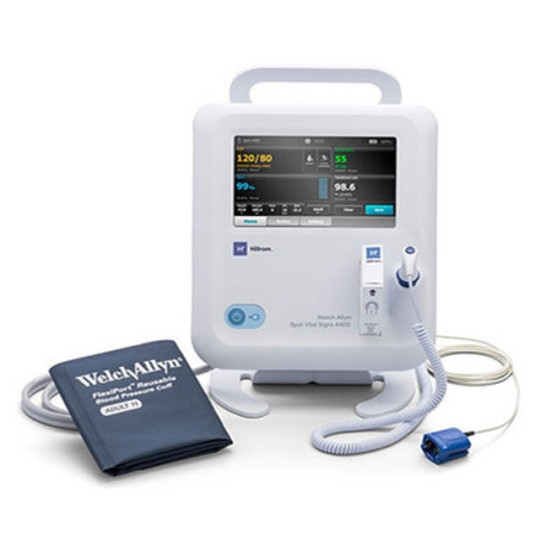
What Is the Welch Allyn Spot Vital Signs Monitor?
The Welch Allyn Spot Vital Signs Monitor is a comprehensive patient monitoring system designed to record essential vital signs with minimal effort and maximum accuracy. Also known as the Welch Allyn Spot Vital Signs 4400 (Spot 4400), this device allows healthcare professionals to measure:
Non-invasive blood pressure (NIBP)
Pulse rate
Body temperature
Oxygen saturation (SpO₂)
Respiration rate
Body Mass Index (BMI)
This multiparameter monitor helps improve workflow and eliminate the inefficiencies of using separate instruments. Its compact design and intuitive user interface make it ideal for clinics, urgent care centers, long-term care facilities, and hospitals.
Features and Benefits of the Welch Allyn Spot Vital Signs Monitor
1. SureBP® Blood Pressure Technology
The Welch Allyn Spot Vital Signs Monitor uses advanced SureBP® technology, delivering accurate readings in approximately 15 seconds—even while the cuff inflates. This reduces patient discomfort and improves throughput in busy environments.
2. SureTemp® Plus Thermometry
Capable of oral, axillary, and rectal temperature measurements, the SureTemp® Plus thermometer included in the Welch Allyn Spot Vital Signs Monitor is fast, accurate, and safe for both adult and pediatric patients.
3. Optional Nonin® SpO₂ Monitoring
Clinics can opt for pulse oximetry functionality using Nonin® technology, allowing for continuous and spot-check SpO₂ monitoring with high accuracy, even in challenging conditions like low perfusion.
4. EMR Connectivity
The Welch Allyn Spot Vital Signs Monitor integrates seamlessly with electronic medical records (EMRs) via USB connection, significantly reducing data entry errors and saving time for clinical staff.
5. 7-Inch Touchscreen Interface
A large, high-resolution touchscreen allows clinicians to navigate, input, and review data easily. The intuitive design ensures minimal training time and maximized productivity.
6. Portable and Long-Lasting
With a powerful lithium-ion battery lasting up to 8 hours, the Welch Allyn Spot Vital Signs Monitor can be used anywhere in your facility without constant recharging.
Why Choose Medical Device Depot?
Medical Device Depot is one of the most trusted suppliers of medical equipment in the United States. They specialize in high-quality devices at competitive prices, with an emphasis on customer support, prompt delivery, and clinical reliability. Purchasing the Welch Allyn Spot Vital Signs Monitor from Medical Device Depot means you get:
Authentic, factory-new devices
Multiple configurations (with or without SpO₂)
Easy online ordering and bulk discounts
Access to technical support and product training
Medical Device Depot understands the unique challenges faced by today’s healthcare professionals and offers solutions that meet those demands.
Clinical Applications of the Welch Allyn Spot Vital Signs Monitor
The Welch Allyn Spot Vital Signs Monitor is versatile enough for a wide range of healthcare settings, including:
Primary Care: Quickly record vitals during routine exams.
Urgent Care: Speed up triage and reduce patient wait times.
Long-Term Care: Monitor residents with less disruption and more accuracy.
Outpatient Clinics: Increase documentation efficiency with EMR integration.
Final Thoughts: Invest in Clinical Excellence
In an industry where time is precious and patient outcomes matter more than ever, the Welch Allyn Spot Vital Signs Monitor is a smart investment. Its blend of reliability, speed, and connectivity makes it an indispensable tool for any medical facility. By sourcing this device through Medical Device Depot, USA, you not only get access to one of the best monitoring systems on the market but also benefit from a supplier that puts your practice’s needs first.
Enhance your clinical workflow today with the Welch Allyn Spot Vital Signs Monitor—available now at Medical Device Depot.
#medical device depot#welch allyn#spot vital signs monitor#welch allyn spot vital signs monitor#vital signs monitor
0 notes
Text
Understanding Varicocele: Causes, Symptoms, and Natural Treatment Options
Varicocele injuries are a condition where the veins in the scrotum become enlarged. In some cases, varicocele can lead to infertility and pain. Surgery is the main form of treatment for varicocele. The majority of people who suffer from varicocele seek out home remedies and varicocele natural treatment to treat it without surgery. This article is intended to provide detailed information about the potency and safety of homeopathic and natural treatments for varicocele.

Comprehending Varicocele:
This medical condition can be identified by a bump along the spermatic cable. This condition is caused by the inability of the valves to function properly when the blood pools inside the veins. Such symptoms are diagnosed at ages such as adolescence and late teenage masters. 15-30% of males have varicocele. The main causes of varicocele are genetics and hormonal anomalies.
Varicocele symptoms include:
The condition is characterized by a constant or dull scrotal pain or discomfort. It gets worse after physical exercise.
A bag of worms can be used to describe the appearance of increased scrotal volume or swelling.
Masses that can be felt in the scrotum or perceived from the outside.
Some cases of testis atrophy are very severe.
Infertility is a result of poor sperm production or abnormal sperm functions.
Natural Remedies For Varicocele
Changes in Diet:
A healthy diet that is balanced should contain a wide variety of fruits, vegetables and whole grains. This will help to maintain and improve the health of the vascular system. To minimize or stop eating processed foods, excessive salt and saturated fats because these are harmful to the body as well as the vascular systems.
Regular Working outs:
Exercise regularly to ensure a good venous return, and therefore, a good blood flow. Simple and non-intense exercises such as walking or cycling are also good for blood circulation. Avoid prolonged sitting and heavy lifting, which can put a strain on your pelvic area.
Homeopathy Varicocele Treatment:
The system is designed to activate and stimulate the body's natural healing mechanism. Homeopathic remedies for best varicocele treatment are chosen according to each person's unique symptoms, constitution, underlying imbalances, and other factors. This remedy can be used for varicocele which is characterized by a sense fullness or heaviness in the scrotum, as well as bruising and soreness. The testicles may feel aching or drag, and the veins can appear dark. This is for varicocele that causes a throbbing, shooting pain. It gets worse with heat and better with cold. Swollen and sensitive, the scrotum can feel dry and swollen.
It can be used to treat varicocele that is caused by injury or trauma in the scrotum. This is for varicocele accompanied by a feeling that the testicles are heavy, and there's a dull aching in the lower back and testicles. The veins could appear swollen or engorged. Constipation may also be present.
Consultation with an experienced homeopathic practitioner who is qualified to diagnose and treat you properly are of paramount importance. In homeopathic medicine for varicocele the axiom "like cures alike" governs. A careful consideration would be made of the patient’s symptoms as well as their general health.
Bharat homeopathy’s varicocele specialists are very diverse. Their exceptional range of knowledge allows patients to participate in modern, innovative practices in Gurgaon which are not found anywhere else in India. Board-certified urologists are part of the expert team. They have received training and certification from some of India's best universities.
Final Takeaway
Varicocele, a condition very common in men, can cause discomfort and even affect their fertility. Most people will opt for natural remedies or varicocele natural cures to alleviate the symptoms and avoid surgery. Homeopathy treats patients according to their symptoms and constitution in order to stimulate the natural healing mechanisms of the body. To ensure safety and effectiveness, it's highly recommended to consult your healthcare provider before beginning any new varicocele treatment without surgery. Integrating natural and holistic therapies can help individuals with varicocele create a plan for restoring their reproductive health and overall well-being.
#homeopathy doctor#healthcare#health and wellness#health#homeopathy near me#mental health#varicocele treatment
0 notes
Text
Why You Should Pursue a Sports Nutrition Certification: Unlock Your Potential in the Fitness Industry
Are you passionate about fitness and nutrition? If you’re considering a career in the health and wellness industry, a Sports Nutrition Certification could be your gateway to success. Whether you're a personal trainer, an athlete, or simply someone who wants to deepen their understanding of sports nutrition, this certification provides the knowledge and credibility to make a real impact. Here’s everything you need to know about the benefits of getting certified and how it can boost your career.
1. Understand Active Ingredients for Optimal Performance
A sports nutrition certification gives you a deep dive into the active ingredients that enhance performance, recovery, and overall well-being. Here's a breakdown of some of the top substances you'll learn about that are essential in maximizing your training and diet plans.
Creatine – Power and Endurance
Creatine is one of the most widely used sports supplements. It helps increase the production of ATP, the energy currency of cells, particularly during high-intensity workouts. This results in increased strength, faster recovery, and improved muscle volume.
Dosage: 3-5g daily, preferably post-workout.
Why It’s Essential: ✔ Supports explosive strength ✔ Enhances endurance and power ✔ Reduces muscle fatigue
Whey Protein – Muscle Building and Repair
Whey protein is a complete source of protein containing all essential amino acids. It aids in muscle growth, recovery, and the prevention of muscle breakdown after intense workouts. If you’re looking to build lean muscle, this is a must-have supplement.
Dosage: 20-30g per serving, taken after workouts or as a meal replacement.
Why It’s Essential: ✔ Aids in muscle recovery and growth ✔ Helps with fat loss when used as a meal replacement ✔ Quickly absorbed by the body for faster repair
Branched-Chain Amino Acids (BCAAs) – Muscle Preservation
BCAAs, which include leucine, isoleucine, and valine, are crucial in preventing muscle breakdown during training. They play a pivotal role in promoting recovery and reducing soreness, especially during intense training regimens.
Dosage: 5-10g before, during, or after workouts.
Why It’s Essential: ✔ Preserves muscle mass during cutting ✔ Enhances recovery and reduces soreness ✔ Improves endurance and performance
Beta-Alanine – Increased Performance
Beta-alanine helps buffer lactic acid in muscles, preventing premature fatigue during intense activities. By taking it regularly, you can push through those last few reps or minutes of cardio, enhancing your overall performance.
Dosage: 3-6g per day, ideally taken pre-workout.
Why It’s Essential: ✔ Increases endurance ✔ Delays fatigue for longer, more intense training sessions ✔ Enhances overall performance
L-Citrulline – Nitric Oxide Booster
L-Citrulline is an amino acid that increases nitric oxide levels in the blood, which improves blood flow to muscles during exercise. This results in better endurance, faster recovery, and a great pump.
Dosage: 6-8g pre-workout.
Why It’s Essential: ✔ Improves blood circulation and oxygen delivery ✔ Enhances muscle pumps and endurance ✔ Reduces muscle fatigue
2. Build a Credible Career with a Sports Nutrition Certification
As a certified sports nutritionist, you will be equipped with the knowledge and skills to advise clients on proper nutrition strategies, supplement regimens, and the importance of combining exercise with optimal nutrition. This certification not only increases your credibility but also helps you stand out in a competitive market.
A sports nutrition certification is highly respected within the fitness and wellness industry, and it opens up many career opportunities, including: ✔ Personal trainer with nutrition expertise ✔ Sports nutritionist for athletes and fitness enthusiasts ✔ Fitness coach offering holistic training programs ✔ Consultant for nutrition and fitness brands
3. Key Benefits of Getting Certified
Expand Your Knowledge
The certification program will provide an in-depth understanding of the biochemistry of nutrients, their role in the body, and how they affect physical performance. You’ll be well-equipped to create personalized nutrition plans for athletes and fitness enthusiasts.
Boost Your Career
Whether you’re working in a gym, offering private consultations, or advising sports teams, the certification will elevate your reputation and make you a go-to expert in your field. It’s a valuable credential for personal trainers, athletes, and fitness influencers.
Better Results for Your Clients
As a certified sports nutritionist, you can offer clients targeted advice that helps them reach their fitness goals faster. Whether it’s building muscle, losing fat, or enhancing performance, your nutritional expertise will provide them with a more comprehensive approach.
Conclusion: Invest in Your Future with a Sports Nutrition Certification
If you're serious about advancing your career in fitness or enhancing your own athletic performance, a sports nutrition certification is the perfect investment. With a deeper understanding of how key nutrients and supplements contribute to physical success, you'll be able to design optimal nutrition plans for yourself or your clients.
Don't wait—unlock your potential today! The knowledge and credibility you gain from a sports nutrition certification will position you as a leader in the fitness industry.
"Explore our website's success stories to see how others have benefited from our expertise."
0 notes